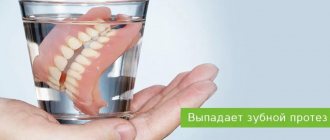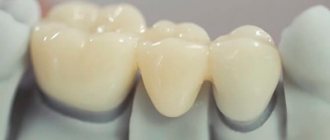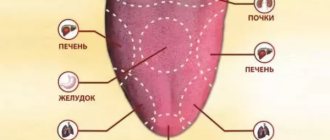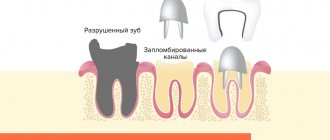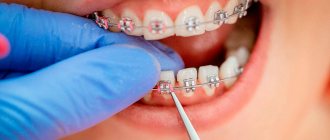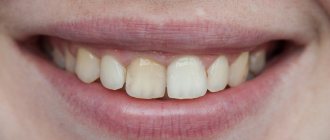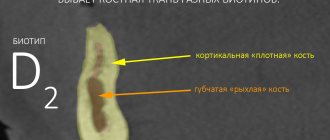Possible causes Problems with the crown on the pin The crown on the implant is loose Temporary crowns How to eliminate risks
“ Doctor, my crown on my tooth is loose, what should I do?
” This question is not uncommon in the dental office. Patients do not always understand why, instead of simply fixing the crown, the doctor prescribes an examination.
The orthopedist’s task is not just to fix the prosthesis, but to find out the reason why the crown is loose after installation.
Without an examination, it is impossible to make an accurate diagnosis, and if the cause is not eliminated, the problem will arise again and again.
The crown on a tooth has become loose - what to do? What could be the reason and how to solve this problem
In case of severe destruction or even complete absence of a tooth, the best option would be to restore it using an artificial crown - supported by a pin or stump inlay, or with the preliminary installation of an implant if the root system is missing. When using high-quality materials and following the technology for performing the procedure, such a single prosthesis will hold firmly and successfully perform its functions for a long time. But if the crown is loose on the tooth, this may be due to an injury or poor treatment. Read further in this article about what to do in such a situation.
Loosening of the cement connection between the crown and the abutment
The prosthetic structure can be fixed on the abutment using dental cement. Sometimes, under the influence of external factors, its composition changes over time. As a result, the cement is destroyed, washed out, and the person notices that the crown on the implant is loose. This may be caused by frequent chewing of very hard foods or eating too hot or cold foods. With cement fixation, it is difficult to remove the crown without damage, so it may need to be replaced. But this option is also possible: the prosthesis is removed, freed from cement residues and installed in place using a new fixing mass.
Why can a crown become loose and what does the strength of cement depend on?
An artificial crown is a single prosthesis that can be fixed to a tooth stump, a pin, a stump inlay or an implant abutment. This is the optimal way to restore a badly damaged or completely missing tooth. If such a crown begins to wobble, there is always a reason. The prerequisite may well be an injury or a medical error made during prosthetics. Mobility of the prosthesis in the latter case is not the only possible complication. Often, poor-quality treatment leads to the development of inflammatory and purulent processes, the development of periodontitis and periostitis.
Inflammation may be the cause of unsteadiness
If the prosthetic device wobbles, this may also indicate changes in the structure of the tissues of the stump after grinding the tooth. During the preparation process, it is necessary to preserve the structure of living tissues, as well as provide abundant water cooling. Otherwise, the hard tissues being processed will overheat, which will inevitably affect their strength and elasticity. With such a clinical picture, soon after prosthetics, the artificial crown may become loose, and then the optimal solution to the problem would be a complete replacement of the structure.
The quality of dental tissue directly affects the strength of fixation of products and the adhesive properties of the dental cement used. For prosthetics to be successful, the doctor must take into account the characteristics of the patient’s bite, the current state of his gums and bone tissue. To do this, a comprehensive diagnosis is first carried out, including an X-ray examination.
Causes
The main reasons causing looseness of a crown or artificial root are:
- the crown has mobility relative to the abutment;
- the connection is damaged or the installation is not performed correctly;
- the implant is unstable, integration into the bone was unsuccessful.
The first two cases are resolved quickly; in many cases, damage to the crown is not required. It’s worse if the cause of looseness is a pin. Causes:
- medical error, the design was implemented incorrectly;
- recommendations for oral care are not followed;
- the Patient's health condition is poor;
- the presence of a number of systemic diseases.
The dentist's mistakes when screwing in the rod include:
- sterility was compromised during the operation;
- the bone is overheated during preparation;
- immersion in the alveolar region is incomplete;
- when screwing in, excessive force was applied to the tissue and implant;
- technology and features of prosthetics were carried out with errors.
Why does de-cementing occur in some cases?
Before installing a single denture, the dentist covers the protruding ground part of the tooth (stump) with a special cap. The product can also be fixed with support on a pin or stump insert. Dental cement is usually used to secure structural elements. If the composition is not of sufficient quality, it will not be possible to achieve strong fixation. In such a situation, the mobility of metal ceramics may be due to the use of too thin or thick cementitious composition.
In other situations, loosening of an artificial tooth becomes a consequence of an incorrect bite if the specialist did not take this point into account before performing prosthetics. Mobility also occurs when small particles of food get under the cap, which is usually the result of incorrect preparation of the ledge or a loose fit of the product.
The photo shows the decementation of the tooth crown
The shape of the inner surface of such a cap must exactly correspond to the anatomical parameters of the stump. This is necessary to ensure tight contact of the product with the stump structure or dental tissues, depending on the method of installing the prosthesis. If the contact density is insufficient, the product will soon become loose and risk simply falling out.
Thus, among the main reasons for decementation, experts in the field of prosthetics identify the following prerequisites: inaccuracy in the shape of the cap or the crown itself, poor preparation of the stump and errors in its preparation, ignoring the characteristics of the bite, and the use of low-quality cement1.
What should the internal cavity of the prosthesis be?
The crown on the tooth must completely repeat the geometric shape of the prepared tooth. Please note that it should not fly off during fitting - if the doctor has to support it with his finger, this is a bad sign. With a high degree of probability, such a product will not be securely fixed, and after a few months or a couple of years the patient will discover that the dental crown has fallen off. A correctly created structure holds securely even without glue-cement - solely due to its tight fit to the tooth’s own tissues.
CAD/CAM equipment is used for the production of all-ceramic dental crowns and prostheses from zirconium dioxide and aluminum, as well as the milling of metals (for example, titanium). The price of artificial teeth made using CAD/CAM technology is usually higher than traditional metal-ceramic ones. However, due to the high precision of manufacturing, such structures have a much longer service life.
How to solve a problem
If the crown is loose on a front or back tooth, do not try to remove it yourself. Only a specialist can do this correctly. After this, the doctor will carefully remove the cement and other elements of the system. After this, you will need to restore the shape of the stump or replace the stump tab. You will have to create a new single prosthesis and install it after all preliminary measures.
If the cause is a cyst
A cyst is a pathological neoplasm in the thickness of the gingival tissue, in the root region. As it grows and fills with purulent exudate, it provokes such unpleasant symptoms as pain with throbbing, inflammation and redness of the gums, the formation of a dense painful lump, increased body temperature and enlarged submandibular lymph nodes.
The photo shows a cyst above the crown
The appearance of a cyst after prosthetics is most often a consequence of the doctor’s negligence, neglect of the rules of asepsis and antisepsis. If you have aching, shooting pain, see a doctor immediately. You will have to take an x-ray to make an accurate diagnosis and prescribe appropriate treatment measures. Sometimes it is enough to remove the tumor surgically, possibly with resection of the root apex. In advanced cases, the tooth is completely removed and subsequent prosthetics are performed on an implant.
After removal of the cyst, the canals are re-treated within 7-10 days. In some cases, specialists prescribe antibiotics, treat the internal structures of the tooth with antiseptics, apply anti-inflammatory drugs and provide temporary prosthetics. Only after complete relief of the pathological process can a permanent prosthesis be installed.
Inflammatory process
If the denture is poorly fixed and a significant gap (more than 0.3 mm) remains between it and the gum, suitable conditions arise for the rapid proliferation of pathogenic microorganisms. Moreover, food debris will constantly get stuck in such a gap and plaque will accumulate. As a result, this will lead to redness and swelling of the adjacent gums - the development of an inflammatory process. Among its characteristic signs, experts identify the following symptoms:
- soreness,
- bleeding,
- severe swelling,
- increased reaction to mechanical and temperature stimuli,
- bad breath due to the addition of purulent processes.
Swelling and pus may form under the crown.
With such a clinical picture, urgent dental care is needed. First you need to find the source of inflammation and stop it. To do this, the doctor will remove the crown and carry out a comprehensive cleaning of the teeth from plaque and subgingival calculus. In the future, the patient will be prescribed antiseptic and anti-inflammatory drugs for self-administration: rinsing solutions (Stomatofit, Rotokan, Chlorophyllipt, Furacilin, etc.) and ointments (Solcoseryl, Cholisal, Asepta) etc.). Only after successful complex therapy will the doctor be able to perform repeated prosthetics.
If the crown falls out along with the implant
If the prosthesis has become mobile and it is installed on an implant, it is better to urgently see your attending surgeon. At any moment, the entire implant system can fall out and lead to other serious consequences, including inflammation of the jaw bone and the rapid development of osteomyelitis. If mobility and loss of the implant occurs due to the development of complications, for example, due to an inflammatory process, peri-implantitis or rejection of the structure, then you need to act very quickly.
The photo shows peri-implantitis
“When I placed my first implant, I encountered a complication. The tissue around the already installed rod became inflamed, and after about a month, that is, not immediately. I had to urgently remove everything and undergo quite a long treatment. I felt terrible then. Until now, no one has really explained to me what happened. I was given a new implant only six months later, and I had to pay the full amount for it again. A very bad experience, after that incident I changed clinics, but I forgot that one like a bad dream.”
Evgenia K., from correspondence on the 32top.ru forum
Usually the entire structure has to be removed, after which anti-inflammatory and antibacterial therapy is carried out. Perhaps, after stopping the pathological process, it will be necessary to perform osteoplasty - to replenish the atrophied areas of bone tissue. After such an operation, you need to wait from 3 to 6 months until the planted material has completely taken root. Only after this can we return to the issue of re-implantation.
Recovery after removal
Restoring a ceramic prosthesis is quite difficult, and only a professional can do such work efficiently. The fact is that when removed, the crown may be damaged or completely destroyed, and it will be impossible to restore the product in order to glue it back. To carry out such events you will need tools and special devices:
- a device equipped with a tip that resembles a crochet hook;
- separator bolt;
- pneumatic hand tools;
- mechanical devices for removing the prosthesis from the mouth;
- spitting utensils;
- forceps.
The manipulations are carried out under local anesthesia, so the patient should not experience pain. Immediately after removal, the denture is sent to a special laboratory, where a dental technician will carefully examine the structure and restore the product. The entire recovery procedure usually lasts no longer than 3-5 hours.
It also happens
If a small chip has formed and the separated part is preserved, then it is simply glued to its original place using medical quick-drying glue. If the fragment is lost, then several ceramic layers are applied to the crown, thereby giving the tooth the required shape. After this, all that remains is to dry the prosthesis; this is done under the influence of high temperature in a special oven.
At the final stage, the technician grinds off excess fragments, grinds the crown and carries out final polishing. But this method is used extremely rarely, since the percentage of prosthesis removal without damage is extremely low. In addition, there is a high probability of injury to the gums and soft mucosal tissues. It is impossible to guarantee that such a design will last a long time, even if the work is done efficiently and professionally.
What can you do at home?
If you are unable to get an appointment with a specialist in the near future, before visiting the doctor you should ensure the maximum level of hygiene and also treat the problem tooth with care. As optimal antiseptic measures, rinsing with Chlorhexidine or Miramistin, tincture of propolis or calendula is recommended, especially if there are signs of an inflammatory process. Among traditional medicine, chamomile, sage, oak bark, and soda-salt solution have proven themselves to be quite good.
Chamomile decoction helps well in treatment
Contraindications
This prosthetic method cannot be used for:
- periodontal disease;
- bruxism (in this case, it is important to first correct the condition or cure the disease, otherwise the structure may damage the teeth that come into contact with the crown when the jaws close);
- malocclusion;
- allergic reactions to metals and alloys;
- shortened crown parts of teeth;
- periodontitis is a temporary contraindication that requires preliminary treatment of the disease.
Preventive measures
To reduce the risk of the crown loosening and falling out, it is important to strictly follow the specialist’s instructions after the procedure, as well as maintain cleanliness and hygiene of the oral cavity. Here's what prosthetics experts recommend in this regard:
- brush your teeth twice a day, rinse your mouth after every meal, use floss. It is advisable to purchase an irrigator - a device that supplies a powerful air-water jet for better cleaning of hard-to-reach places. You can read more about the principle of operation of the irrigator and popular models of the device in our special article,
- follow some nutritional principles. For example, immediately after the procedure you will have to give up products that are too hard and stretchy. Subsequently, it is better to forget about the habit of gnawing seeds with your teeth and cracking the shell,
- It is better to quit smoking and drinking alcohol too often,
- treat the installed structure carefully and carefully, regularly check it for chips, cracks and other damage,
- When the first alarming symptoms appear, you should immediately consult a doctor.
To maintain your smile, proper dental hygiene is important.
After dentures, do not forget to visit the dentist every six months for preventive examinations and a professional. hygiene. At each such appointment, the doctor will evaluate not only the condition of the teeth and gums, but also the integrity and functionality of the installed dentures. If necessary, when the product’s expiration date approaches, a specialist will prescribe its timely replacement.
1Massironi, D. Precision and aesthetics. Clinical and dental stages of dental prosthetics, 2008.
Structure and types
Metal-ceramic dental prosthetics got its name due to the structure of the structures: inside it has a cast metal frame with a thickness of 0.3-0.5 mm. The material of manufacture is cobalt or nickel-chromium alloys. In some cases, alloys of precious metals - platinum or gold, palladium and others in different proportions - can be used. Crowns are divided into corresponding types according to this parameter.
The use of gold has an undeniable advantage - due to the natural yellowness of the precious metal, it is possible to achieve a natural shade of the structure, which is especially in demand when it is necessary to replace the front teeth.
The metal frame is covered with ceramics. The base is veneered using manual layer-by-layer application of ceramic mass. The structure is fired in a kiln after each layer is applied - this allows for the best connection between metal and ceramics.
As for the structure of the structure, the following types of metal-ceramics in dental prosthetics are distinguished:
- Actually single crowns. They are widely used to restore teeth in the lateral zone when they are more than ⅔ destroyed.
- Bridges. They are designed to restore several missing teeth in a row. The most reliable design is considered to be two crowns for supporting teeth and 2 artificial teeth between them.
